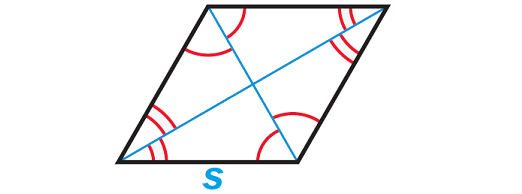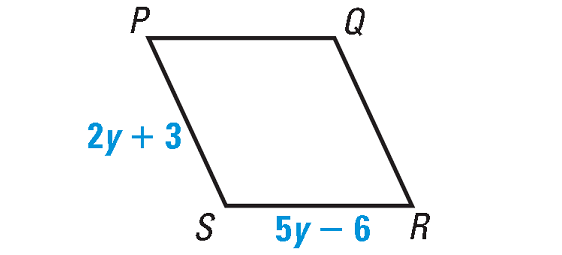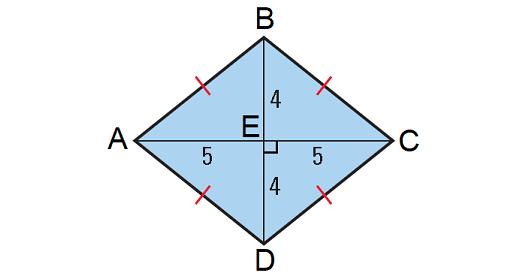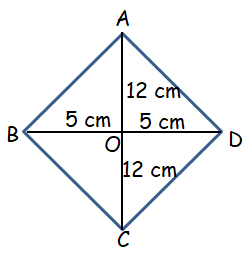PERIMETER OF RHOMBUS
Subscribe to our ▶️ YouTube channel 🔴 for the latest videos, updates, and tips.
A rhombus is a four-sided closed figure where the lengths of all the four sides will be equal and also the diagonals will be perpendicular.

Let 's' be the length of each side of a rhombus.
Perimeter of the Rhombus = 4s
Example 1 :
Find the perimeter of the rhombus whose side length is 16 cm.
Solution :
Formula for perimeter of a rhombus :
= 4s
Substitute 16 for s.
= 4(16)
= 64
So, the perimeter of the rhombus is 64 cm.
Example 2 :
If the perimeter of a rhombus is 72 inches, then find the length of each side.
Solution :
Perimeter of the rhombus = 72 inches
4s = 72
Divide each side by 4.
s = 16
So, the length of each side of the rhombus is 16 inches.
Example 3 :
A rhombus has side length of 500 cm. Find its perimeter in meter.
Solution :
Formula for perimeter of a rhombus :
= 4s
Substitute 500 for s.
= 4(500)
= 2000 cm -----(1)
We know
100 cm = 1 m
Therefore, to convert centimeter to meter, we have to divide by 100.
(1)-----> Perimeter = 2000 cm
Divide the right side by 100 to convert cm into m.
Perimeter = (2000 / 100) m
= 20 m
So, perimeter of the rhombus is 20 meters.
Example 4 :
If the length of each side of a rhombus is (3x + 4) and its perimeter is 76 units, find the value of x.
Solution :
Perimeter of the rhombus = 76 units
4s = 76
Divide each side by 4.
s = 19
Substitute (3x + 4) for s.
3x + 4 = 19
Subtract 4 from each side.
3x = 15
Divide each side by 3.
x = 5
Example 5 :
In the diagram shown below, if PQRS is a rhombus, then find its perimeter.
Solution :

All four sides of a rhombus are congruent.
So,
RS = PS
5y - 6 = 2y + 3
Subtract 2y from each side.
3y - 6 = 3
Add 6 to each side.
3y = 9
Divide each side by 3.
y = 3
To find the length of each side of the rhombus, substitute 3 for y either in '2y + 3' or '5y - 6'.
2y + 6 = 2(3) + 3
2y + 6 = 6 + 3
2y + 6 = 9
So, the length of each side of the rhombus is 9 units.
Formula for perimeter of a rhombus :
= 4s
Substitute 9 for s.
= 4(9)
= 36
So, perimeter of the rhombus is 36 units.
Example 6 :
Find the perimeter of the rhombus shown below.

Solution :
Find the length of the side MN in the above rhombus using distance formula.
MN = √[(x2 - x1)2 + (y2 - y1)2]
Substitute (x1, y1) = (2, 1) and (x2, y2) = (6, 3).
LM = √[(x2 - x1)2 + (y2 - y1)2]
LM = √[(6 - 2)2 + (3 - 1)2]
LM = √(42 + 22)
LM = √(16 + 4)
LM = √20
LM = 2√5
All four sides of a rhombus are congruent.
Then, the length of each side of the above rhombus is 2√5 units.
Formula for perimeter of a rhombus :
= 4s
Substitute 2√5 for s.
= 4(2√5)
= 8√5
So, perimeter of the rhombus is 8√5 units.
Example 7 :
In the rhombus ABCD shown below, if the lengths of the diagonals AC and BD are 10 units and 8 units respectively, find its perimeter.

Solution :
The diagonals of a rhombus will be perpendicular and they will bisect each other.
Then, we have

In the above rhombus, consider the right angled triangle CDE.
By Pythagorean Theorem,
CD2 = DE2 + CE2
CD2 = 42 + 52
CD2 = 16 + 25
CD2 = 41
CD = √41
All four sides of a rhombus are congruent.
Then, the length of each side of the above rhombus is √41 units.
Formula for perimeter of a rhombus :
= 4s
Substitute √41 for s.
= 4√41
So, perimeter of the rhombus is √41 units.
Example 8 :
The length of the diagonals of a rhombus are 24 cm and 10 cm, respectively. Find out the length of all its sides.
Solution :
In rhombus all sides will be equal. Let x be the length of side. Diagonals will bisect each other at right angle.

AD2 = AO2 + OD2
AD2 = 122 + 52
AD2 = 144 + 25
AD2 = 169
AD = 13 cm
Perimeter of rhombus = 4(13)
= 52 cm
Example 9 :
Find the length of a side of a rhombus whose perimeter is 60 cm .
Solution :
Perimeter of rhombus = 60 cm
Side length of rhombus be x
4x = 60
x = 60/4
x = 15
So, side length of rhombus is 15 cm.
Example 10 :
If each side of a rhombus is doubled, how much will its area increase?
(a) 1.5 times (b) 2 times (c) 3 times (d) 4 times
Solution :
Let x be the side of the rhombus and h be the height.
Area = xh
Since the side is doubled, 2x will be the new side.
Area = 2x h
So, option b is correct.
Subscribe to our ▶️ YouTube channel 🔴 for the latest videos, updates, and tips.
Kindly mail your feedback to v4formath@gmail.com
We always appreciate your feedback.
About Us | Contact Us | Privacy Policy
©All rights reserved. onlinemath4all.com
Recent Articles
-
10 Hard SAT Math Questions (Part - 40)
Dec 23, 25 06:12 AM
10 Hard SAT Math Questions (Part - 40) -
AP Calculus BC Problems with Solutions
Dec 20, 25 10:51 AM
AP Calculus BC Problems with Solutions -
AP Precalculus Problems and Solutions (Part - 1)
Dec 20, 25 10:49 AM
AP Precalculus Problems and Solutions (Part - 1)
